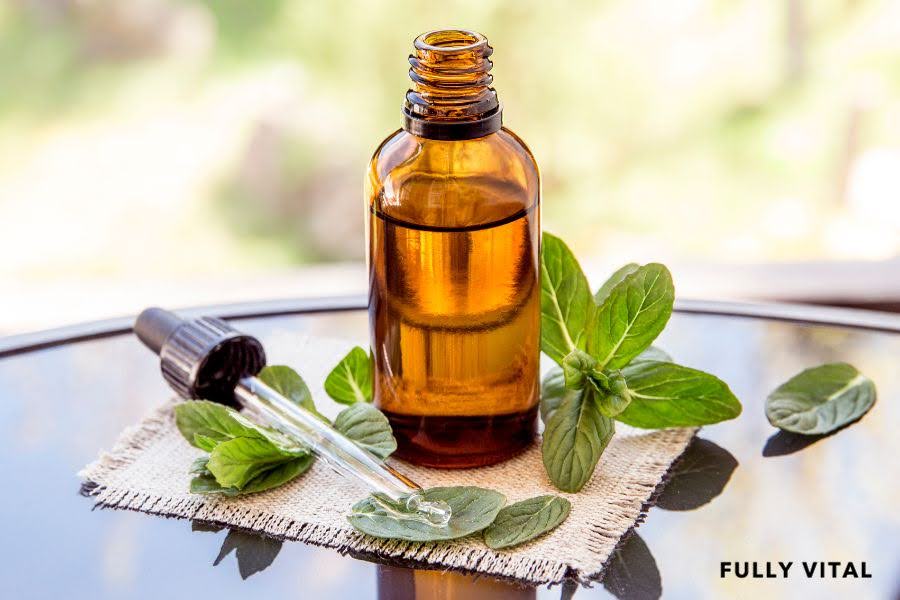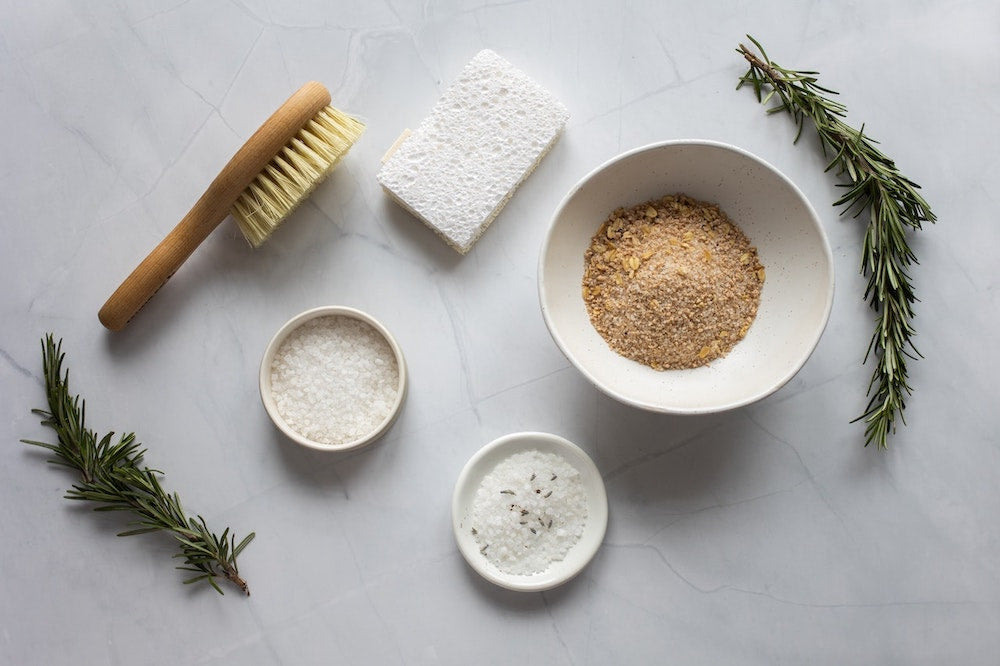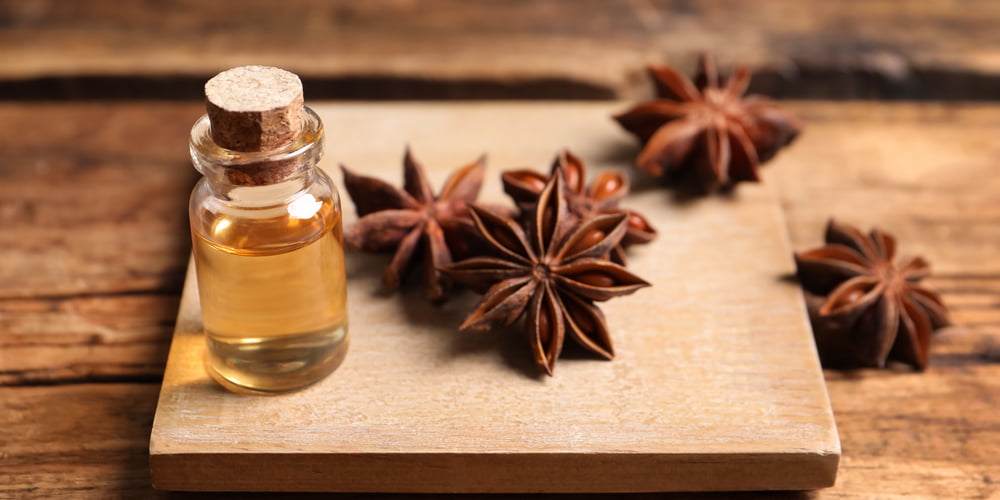
Peppermint Oil For Hair Growth: Benefits, Uses, Side-Effects
Welcome to Fully Vital's guide on how to use peppermint oil to help your hair grow!
If you want a natural way to make your hair grow and keep your scalp healthy, you're in the right spot.
In this article, we'll talk about why peppermint oil is good for your hair, how to use it, and any possible side effects to watch out for.
It doesn't matter if your hair is straight, curly, or coily – peppermint oil could be the secret to getting the beautiful hair you've been dreaming of.
Let's learn all about peppermint oil and how it can help your hair grow.

I LOVE MY HAIR NOW
FullyVital hair serum and hair vitamins made tremendous improvements in my hair. I truly love my hair now.
Dorit S.,
Understanding Hair Growth
To understand how peppermint oil can help with hair growth, we need to know a bit about how hair grows.
Hair growth happens in three main stages: anagen (active growth), catagen (slower growth), and telogen (resting and shedding old hair).1
Peppermint oil is believed to boost blood flow to the scalp, which might make hair grow better by making the active growth phase (anagen) longer and increasing the number of hair follicles that are actively growing.2
Knowing this hair growth cycle helps us see how peppermint oil could be good for hair growth.
The Science Behind Peppermint Oil And Hair Growth
The idea that peppermint oil helps with hair growth isn't just a myth; it's backed by science.
The secret behind its effectiveness is menthol, the main ingredient in peppermint oil.
Menthol has a special effect on blood vessels; it makes them widen.
When you put peppermint oil on your scalp, the menthol makes the blood flow better, bringing more blood, oxygen, and nutrients to your hair follicles.
This process can potentially wake up hair follicles that aren't working well and make your hair grow for a longer time.
Now, let's take a closer look at what makes peppermint oil a trustworthy choice for getting thicker hair.
Menthol: The Hair Growth Champion
Menthol, the hero compound in peppermint oil, is lauded for its ability to induce blood vessel dilation.
This biological activity is crucial because healthy hair growth is largely dependent on adequate blood flow to the scalp.
Enhanced circulation means that hair follicles are fed with a rich supply of the vital substances they need to produce strong, healthy hair shafts.
Peppermint Oil Research Findings
Scientific studies have shown that peppermint oil has the potential to help with hair growth.3
One important study found that using peppermint oil regularly improved hair thickness, increased the number of hair follicles, and made the follicles go deeper into the skin.
Surprisingly, peppermint oil did better in these aspects compared to minoxidil, a common treatment for hair growth.
Research also suggests that applying peppermint oil could reduce hair loss caused by inflammation or fungal infections because it has properties that fight microbes.

The Role of Peppermint Oil in Anagen Phase Prolongation
Hair growth occurs in cycles, including the anagen (growth), catagen (transition), and telogen (rest) phases.
Peppermint oil may have a positive impact on the anagen phase, prolonging it and thereby supporting longer growth periods for hair.
This means that individual hairs may have a longer life span before naturally shedding, leading to greater hair retention and density.
Applying Peppermint Oil For Hair Growth
Embracing peppermint oil for hair growth involves more than just recognizing its benefits; it necessitates understanding the right application methods to facilitate efficient use and maximize its potential.
Following the correct procedures not only ensures safety but also enhances the oil's efficacy.
By integrating peppermint oil into your hair care routine with intention and knowledge, you're paving the way for improved hair health.
Here are the steps and best practices for using peppermint oil to encourage lush, thick hair growth.
Creating the Perfect Peppermint Oil Blend
Begin by preparing a peppermint oil blend suitable for your hair type and concerns.
Because of its intensity, peppermint essential oil should always be diluted with a carrier oil such as jojoba, coconut, or almond oil to prevent irritation.
A general guideline is to add 2-3 drops of peppermint essential oil per tablespoon of carrier oil, which can be adjusted based on personal tolerance.
Massaging for Maximum Absorption
Once you have your blend ready, apply it to the scalp with a gentle massaging action.
Use the tips of your fingers to work the oil into the scalp in circular motions; this not only ensures even distribution but also boosts blood circulation further.
The massage technique can itself contribute to hair growth by stimulating the hair follicles.
Time Allocation for Treatment
After applying the peppermint oil blend to the scalp, it's beneficial to allow it some time to penetrate deeply and act on the hair follicles.
A recommended duration is at least 30 minutes, though some prefer an overnight treatment for more intensive care.
If you're planning to leave the oil on your scalp for extended periods, make sure it's well diluted to avoid potential irritation.
Rinsing with Care
Post-treatment, thoroughly rinse the peppermint oil out of your hair.
Given its strong scent and cooling sensation, ensure that all residue is cleaned to prevent any discomfort.
Use a mild, natural shampoo to wash your hair, and follow up with a nourishing conditioner to keep your locks hydrated and healthy.
Frequency of Application
Consistency is key when it comes to seeing tangible results.
The frequency of applying peppermint oil will depend on your hair's condition and how it reacts to the treatment.
As a starting point, consider a once-a-week application and observe how your hair and scalp respond.
You can adjust the frequency over time, with the goal being to find a balance that supports your hair growth without causing irritation.

Combining Peppermint Oil With Other Essential Oils
While peppermint oil on its own can be a potent ally in the quest for hair growth, its efficacy can be enhanced by combining it with other essential oils known for their hair health benefits.
Such combinations can create a synergy, leveraging the different properties of each oil to target various aspects of hair and scalp health, leading to a comprehensive treatment solution.
Here's how to thoughtfully pair peppermint oil with other essential oils to create a powerful hair care blend that resonates with the natural, health-oriented ethos of Fully Vital users.
Rosemary Oil: A Perfect Partner for Peppermint
Rosemary oil is celebrated for its ability to improve cellular generation and is often recommended for hair growth and scalp health.
A study has shown it to be as effective as minoxidil, a common hair growth medication, making it an excellent companion to peppermint oil.
To use, add a few drops of rosemary oil to your peppermint oil blend.
This can strengthen hair follicles and promote a healthier growth environment.
Lavender Oil: Soothing and Nourishing
Lavender essential oil is known for its soothing properties and its ability to not only promote hair growth but also reduce stress—a common contributor to hair loss.
It has antimicrobial properties that can help prevent and treat scalp issues.
Blend lavender oil with peppermint oil to create a calming and healing scalp massage oil that encourages healthier, stronger hair.
Tea Tree Oil: Clarifying the Scalp
Tea tree oil's antiseptic properties make it ideal for cleansing the scalp and combating dandruff and other scalp conditions.
When mixed with peppermint oil, it can provide a clean, healthy scalp, which is essential for optimal hair growth.
Since tea tree oil is very potent, a small amount goes a long way in preventing buildup, without stripping the scalp of its natural oils.
Cedarwood Oil: Stimulating Hair Growth
Cedarwood essential oil is believed to balance the oil-producing glands in the scalp, which can contribute to hair growth and reduce hair loss.
It also has antifungal and antibacterial properties, addressing potential scalp issues that might hinder hair growth.
A blend of cedarwood and peppermint oils can stimulate the scalp and invigorate hair follicles.
Jojoba and Argan Oil: Nourishing with Carrier Oils
While not essential oils, jojoba and argan oil make excellent bases or carrier oils for peppermint oil mixtures.
Jojoba oil's structure closely resembles natural sebum, which means it can deeply hydrate hair and scalp without leaving an oily residue.
Argan oil is rich in vitamin E and antioxidants which can provide nourishment and protect hair from damage.
Blending peppermint oil with these carrier oils can enhance moisture retention while promoting hair growth.
Tips For Buying And Preserving Peppermint Oil
When purchasing peppermint oil for hair growth, it's essential to look for 100% pure and natural oil without any added chemicals or synthetic fragrances.
Opt for products that are specifically labeled as "pure peppermint oil" or "100% essential oil."
To preserve the potency of peppermint oil, store it in a cool, dark place away from direct sunlight and heat.
Additionally, ensure that the bottle is tightly sealed to prevent oxidation and maintain its efficacy.
It's recommended to use the oil within one to two years of purchase for optimal results.
Discover The Power Of Fully Vital Hair Growth ProductsAt Fully Vital, we understand the frustration and disappointment that comes with aging hair. That's why we've developed a range of hair growth products that are designed to rejuvenate and revitalize your locks. Here are the key features and benefits of our products:
By choosing Fully Vital hair growth products, you are taking a step towards rejuvenating your hair and regaining your confidence. Say goodbye to aging hair and hello to a healthier, more vibrant mane. |
Final Thoughts On Peppermint Oil
Peppermint oil has been proven to be a beneficial and natural remedy for promoting hair growth.
With its refreshing scent and powerful properties, it can be a great addition to your hair care routine.
Whether you have fine, curly, coarse, or straight hair, peppermint oil can potentially help stimulate hair growth and improve overall hair health.
As with any natural remedy, it's important to use peppermint oil cautiously and in moderation to avoid potential side effects.
Always conduct a patch test and dilute the oil with a carrier oil before applying it to your scalp.
At Fully Vital, we recognize the potential of peppermint oil for hair growth, which is why we incorporate it into some of our science-backed hair growth products.
Our mission is to offer women of all hair types the tools they need to maintain and improve the health of their locks.
By leveraging the power of nature and science, we aim to help you achieve the healthy and luscious hair you desire.
Check out our recent blogs:
- Unlocking The Truth: Unveiling Side Effects Of Rice Water On Hair Health
- Get Trendy With Microbangs: Your Ultimate Guide To Styling And Maintenance
- Effective Strategies For Scalp Yeast Infection Relief: Understanding Causes, Symptoms, And Treatment Options
Frequently Asked Questions on Peppermint Oil For Hair Growth
How does peppermint oil promote hair growth?
Peppermint oil can improve blood circulation and stimulate hair follicles, promoting hair growth.
How to use peppermint oil for hair growth?
You can mix a few drops of peppermint oil with a carrier oil and massage it into your scalp.
Leave it on for 5-10 minutes before rinsing.
What are the potential side effects of peppermint oil?
Potential side effects include scalp irritation, allergic reactions, and sensitivity to sunlight.
Is peppermint oil safe to use on all hair types?
Peppermint oil is generally safe for all hair types, but a patch test is recommended, especially for sensitive or damaged hair.
How often should I use peppermint oil for hair growth?
Using peppermint oil 2-3 times a week is recommended for hair growth.
Does peppermint oil help with dandruff?
Yes, the antimicrobial properties of peppermint oil can help alleviate dandruff.
Can peppermint oil help with hair loss?
Peppermint oil may help reduce hair loss by improving scalp health and stimulating hair follicles.
Can peppermint oil prevent greying of hair?
There's no scientific evidence that peppermint oil can prevent greying of hair.
Is peppermint oil effective on all hair textures?
Yes, peppermint oil can be effective on all hair textures.
Sources:
- Geyfman, M., Plikus, M. V., Treffeisen, E., Andersen, B., & Paus, R. (2014). Resting no more: re-defining telogen, the maintenance stage of the hair growth cycle. Biological Reviews, 90(4), 1179–1196. https://doi.org/10.1111/brv.12151
- Peiffer, V. (2013). Regrowing Hair Naturally: Effective Remedies and Natural Treatments for Men and Women with Alopecia Areata, Alopecia Androgenetica, Telogen Effluvium and Other Hair Loss Problems. In Google Books. Singing Dragon. https://books.google.com.ph/books?hl=en&lr=&id=haGFaUQvsFkC&oi=fnd&pg=PA2&dq=+Peppermint+oil+is+believed+to+boost+blood+flow+to+the+scalp
- Oh, J. Y., Park, M. A., & Kim, Y. C. (2014). Peppermint Oil Promotes Hair Growth without Toxic Signs. Toxicological Research, 30(4), 297–304. https://doi.org/10.5487/tr.2014.30.4.297







